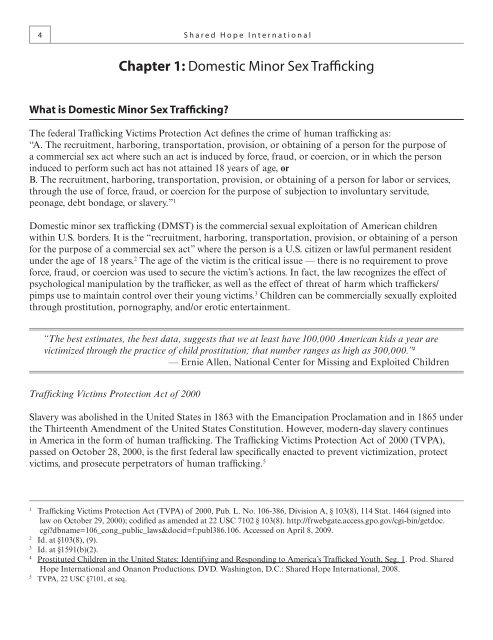By Linda A Smith Samantha Healy Vardaman Melissa A Snow
The National Report on Domestic Minor Sex Trafficking
The National Report on Domestic Minor Sex Trafficking
You also want an ePaper? Increase the reach of your titles
YUMPU automatically turns print PDFs into web optimized ePapers that Google loves.
4Shared Hope InternationalChapter 1: Domestic Minor Sex TraffickingWhat is Domestic Minor Sex Trafficking?The federal Trafficking Victims Protection Act defines the crime of human trafficking as:“A. The recruitment, harboring, transportation, provision, or obtaining of a person for the purpose ofa commercial sex act where such an act is induced by force, fraud, or coercion, or in which the personinduced to perform such act has not attained 18 years of age, orB. The recruitment, harboring, transportation, provision, or obtaining of a person for labor or services,through the use of force, fraud, or coercion for the purpose of subjection to involuntary servitude,peonage, debt bondage, or slavery.” 1Domestic minor sex trafficking (DMST) is the commercial sexual exploitation of American childrenwithin U.S. borders. It is the “recruitment, harboring, transportation, provision, or obtaining of a personfor the purpose of a commercial sex act” where the person is a U.S. citizen or lawful permanent residentunder the age of 18 years. 2 The age of the victim is the critical issue — there is no requirement to proveforce, fraud, or coercion was used to secure the victim’s actions. In fact, the law recognizes the effect ofpsychological manipulation by the trafficker, as well as the effect of threat of harm which traffickers/pimps use to maintain control over their young victims. 3 Children can be commercially sexually exploitedthrough prostitution, pornography, and/or erotic entertainment.“The best estimates, the best data, suggests that we at least have 100,000 American kids a year arevictimized through the practice of child prostitution; that number ranges as high as 300,000.” 4— Ernie Allen, National Center for Missing and Exploited ChildrenTrafficking Victims Protection Act of 2000Slavery was abolished in the United States in 1863 with the Emancipation Proclamation and in 1865 underthe Thirteenth Amendment of the United States Constitution. However, modern-day slavery continuesin America in the form of human trafficking. The Trafficking Victims Protection Act of 2000 (TVPA),passed on October 28, 2000, is the first federal law specifically enacted to prevent victimization, protectvictims, and prosecute perpetrators of human trafficking. 51Trafficking Victims Protection Act (TVPA) of 2000, Pub. L. No. 106-386, Division A, § 103(8), 114 Stat. 1464 (signed intolaw on October 29, 2000); codified as amended at 22 USC 7102 § 103(8). http://frwebgate.access.gpo.gov/cgi-bin/getdoc.cgi?dbname=106_cong_public_laws&docid=f:publ386.106. Accessed on April 8, 2009.2Id. at §103(8), (9).3Id. at §1591(b)(2).4Prostituted Children in the United States: Identifying and Responding to America’s Trafficked Youth, Seg. 1. Prod. SharedHope International and Onanon Productions. DVD. Washington, D.C.: Shared Hope International, 2008.5TVPA, 22 USC §7101, et seq.
















